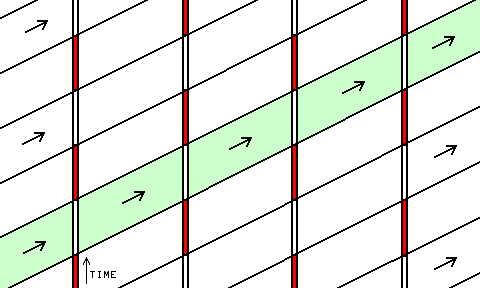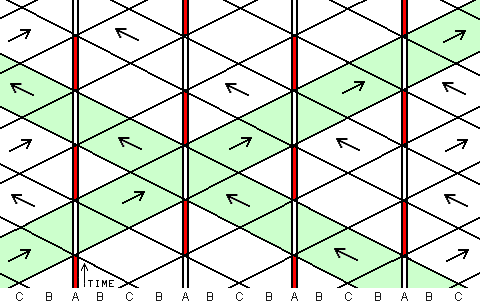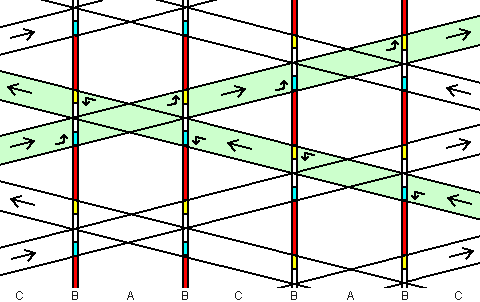TRAFFIC SIGNAL PROGRESSION
You have probably seen traffic signal progression and not known what it was. As you drive on a major street,
the lights turn green as you come to them. The traffic on the major street forms into "platoons" of
cars that pass through the intersections when the signals at those intersections are green. This sounds like a
simple task to accomplish. With a one-way street and few arterial cross-streets, it is simple. But the
following complications can make the calculations become quite difficult:
- A two-way street
- Arterial cross-streets close together
- A route that turns
- Left-turn signals
- Short blocks
SIMPLE PROGRESSION ON AN ISOLATED ONE-WAY STREET
The isolated one-way street is the easiest kind of street to progress. There are no interactions that need
to be considered, so setting up the signal timing relations is easy. The following factors determine the
necessary settings:
- The traffic cycle is one complete repetition of all of the signal displays at the intersection. For the
purposes of progression, the traffic cycle can be likened to the rotating second hand on a clock, except
that the hand may take a period other than one minute, depending on the cycle length (the time taken for one
traffic cycle to occur).
- The higher the traffic demand on each lane, the longer the cycle length needs to be. This is because
time is always wasted at the ends of the green period (due to start-up delays and the variations in driver
reaction to the yellow light).
- For progression to work, all of the signals must use the same cycle length.
- Only the demand of traffic affects the cycle length of this progression system. The distance between
signals does not affect one-way progression.
- The first signal is used as the timing reference point.
- The offset of a signal is the delay of the center of the green period of that signal, compared to the
center of the green period of the reference signal. On an isolated one-way street, the only factor affecting
the offset is the time it takes vehicles to travel from one signal to the next.
- The split for one street of a traffic signal is the fraction of a cycle the signal is green for that
street. The split is usually determined by the ratio of traffic demand between the two streets.
- The bandwidth of this one-way progression is determined by the smallest split on the street.
- If parking is allowed on the progressed street, it can disrupt the platoons of vehicles.
Here is an example of a street with one-way progression, with a time-space diagram, and an animated view
of the street. The horizontal direction of the time-space diagram runs along the street, and shows distance.
Time flows upward on the time-space diagram.

Figure 1: ONE-WAY STREET.
Notice how the platoons of cars arrive at each signal when it is green.
File size limitations on my website account for the jerkiness of the animation. Also note that in the
sped-up animations on this page, the yellow periods would be too short to be visible.
PROGRESSION ON AN ISOLATED TWO-WAY STREET
When traffic is moving in both directions on the same street, it makes progression a lot more complicated.
With two-way traffic, either the street must be progressed in only one direction, or a two-way progression
that works must be found. Now, the signals must be placed at strategic points with respect to the distance
traveled in one signal cycle. This is because the signals for both directions of travel must usually be green
at the same time at the same intersection. The ideal spacing of signals is one half-cycle of travel time
apart. This makes the signals alternate, so that when any one signal is green, the next signal is red. Thus,
each signal is displaced one half of a cycle from the signals before and after it.
The alternating plan is the simplest of the two-way progression methods, and it has the highest bandwidth
of any two-way plan. Here is an example of two-way alternating progression:

Figure 2: TWO-WAY STREET - SINGLE-ALTERNATE
Notice how the platoons of cars arrive at each signal when it is green.
The following factors must be considered when designing progression for a two-way street:
- The cycle length is no longer independent of the distance between signals. Now the allowable cycle
lengths depend on the spacings between signals and the normal speed of the traffic.
- As traffic becomes heavier, the cycle length needs to be longer. But heavier traffic usually also runs
at slower speeds, allowing the cycle length to be increased.
- Short block lengths make it harder to find an optimum progression plan.
- Uneven signal spacing makes the job of finding a good two-way progression plan more difficult. In some
cases, there is no solution to the problem of finding a two-way progression. In these cases, some of the
measures listed in a list of tricks to increase progression bandwidth (below) must be used.
- On the diagram, the points labeled A are the ideal places for streets.
- The points labeled B on the diagram are non-ideal places for streets. But they can be used if existing
left turn phases can be sequenced to aid progression.
- The points labeled C are places where ordinary traffic signals should not be placed.
- Any signal with left turn phases on both streets is a poor candidate for progression.
Where the block lengths are so short that the shortened cycle lengths can't pass the traffic, the
double-alternating plan is used. With this plan, pairs of signals show green at the same time, while the
adjacent pairs show red. The signals are at the points labeled B. This allows two-way progression, but with
a smaller bandwidth:

Figure 3: TWO-WAY STREET - DOUBLE-ALTERNATE
Note that, although the split between the two streets as shown is 50 percent (for ease in preparing the
exhibit), the usual case for double alternate has a larger split for the progressed street.
The following colors are on the progression diagram:
- Green - The path of one platoon of cars through the signals.
- Red - The signal is red.
- Cyan - A leading left turn phase.
- Yellow - A lagging left turn phase.
LEFT-TURN SIGNALS AND TWO-WAY PROGRESSION
By reducing the through band, left-turn signals usually hinder progression. But if double-alternating
progression is used, and provision is made to prevent yellow-trap, leading and
lagging turns can make progression more efficient. Observe in Figure 3 above how the leading and lagging
greens allow turns during the periods when only one through band is using the intersection. The signals
are placed at the points labeled B.
At places where the through bands do not coincide, phasing designs can indicate split-phase operation,
separated- phase operation (where other phases isolate in time the phase for one direction from the phase
for the opposite direction), and dual-green operation (where the progressed street gets two green lights
per cycle). While being inefficient, these phase patterns can solve otherwise unsolvable progression
problems. They can be utilized as follows:
- Ordinary two-phase signals work best near point A.
- Signals with dual leading left turns also work best near point A.
- Signals with lead-lag phasing work best near point B, or between points A and B.
- Split-phase signals work best between points B and C.
- Dual green signals work best near point C, but give poor bandwidths.
- Half signals work anywhere on the diagram, because they stop artery traffic in only one direction.
- Signals with left turn signals in all four directions usually cannot be progressed.
TWO-WAY PROGRESSION WITH UNEQUAL BLOCK LENGTHS
Unequal block lengths complicate the calculation of progression on a street. The best plan, if it can
be accomplished, is to place the longest blocks in the places in the progression plan at those quarter-cycle
points that are between the half-cycle points (the points labeled C). Otherwise, some signals might have to
be removed and replaced with stop signs on the side streets. See the tips listed below.
PROGRESSION ON A PAIR OF ONE-WAY STREET
If the two one-way streets are a block apart, progression on the streets themselves is no problem, until
the high-volume cross-streets are factored in. The low-volume cross streets do not need to be progressed
between the two one-way streets, so the offset on the low-volume street at one one-way street needs no
relationship to the offset at on the other one-way street. But major cross streets always pose a problem
where they cross a pair of progressed one-way street, because:
- Those cross streets must almost always be progressed in double-alternate mode, unless the one-way
streets are several blocks apart.
- The offset relationships between the two one-way streets are coupled together at the major cross
streets. Often both one-way streets must have the same offset at a major street.
- If two major streets are close together, the progression calculations become difficult.
- Where one closely spaced pair of one-way streets crosses another closely-spaced pair, each pair
reduces the through band of the other, because both pairs usually must have double-alternate progression
at these intersections. Larger spacing can eliminate this problem.
- It is possible to progress two intersecting pairs of one way streets with all 4 signals acting in
unison.
PROGRESSION WITH A GRID OF STREETS
Depending on the grid of streets, progression over the grid can be easy or hard:
- If the streets are regularly spaced at large enough distances that the signals can be placed at
half-cycle distances, grid progression is easy, whether the streets are one-way or two-way.
- Uneven block lengths, diagonal streets, short block lengths, and curves in streets can complicate
grid progression to the point where it can't be done.
- One-way streets can help to make grid progression easier.
- Use half-signals where possible.
- Avoid signals with left turn phases on both streets where possible.
If one-way streets are evenly spaced and evenly loaded with even speeds, and the bandwidth
can be less than 50%, then the four-blocks-per-cycle plan (Figure 4 below) can be used.

Figure 4: GRID PROGRESSION - ONE-WAY STREETS
WHAT IF A PROGRESSED ROUTE MAKES A TURN AT AN INTERSECTION?
The street directions must alternate, with one direction being red while the other direction is green:
- This fits into the time-space diagram at the places where streets should not be normally placed, at point C.
- This works at the same places dual green signals work, but with a larger bandwidth.
- If one direction can be given a free right turn, it simplifies the progression timing to that of a half-signal
for the other direction.
- A "route turns" selection is built into the progression calculator provided here (see below).
INTEGRATING A TRAFFIC INTERCHANGE INTO A PROGRESSION PLAN
Different kinds of interchanges require different progression methods:
- Roundabout
- This must be kept away from signalized intersections. Progression does not survive passage through a roundabout.
- Diamond Interchange with unsaturated turn flows
- The phasings of the two ramp intersections can be adjusted to work at any points in the diagram.
- Diamond Interchange with saturated turn flows
- This uses the quad clockwise phasing, and works best at point C. Enter both signals as a single signalized
intersection with the route turns selection.
- Diverging Diamond Interchange
- The street directions must alternate, so point C is best. Since there is no cross street phase, bandwidth
can be high. Use the route turns selection, and enter both signals as one intersection.
- Split Diamond Interchange, especially when used with a pair of one-way streets.
- This uses the quad clockwise phasing, and works best at point C. At low traffic, can be used at point A.
- Single Point Urban Interchange
- This works best at point A. But lead-lag phasing can be used for point B.
- Two Quadrant Parclo
- Treat this as a diamond interchange for the purpose of phasing. But it can not be used with quad clockwise.
- Four Quadrant Parclo with diamond off ramps
- Treat this as two 2-phase intersections. With special channelization, it can be two half signals.
- Four Quadrant Parclo with diamond on ramps
- Treat this as two half signals.
- Full Cloverleaf Interchange
- This should be placed far away from any traffic signals. Progressed platoons cause weaving problems on the loop ramps.
- Echelon Interchange
- Treat this as two half signals. But do not allow other signalized intersections to be too close, due to the merging.
- Other interchanges
- These must be analyzed individually.
TRICKS TO INCREASE PROGRESSION BANDWIDTH
Use these tricks to increase progression bandwidth:
- Try different timing splits between the progressed street and the cross street.
- Try different cycle lengths. Increase it if the system starts to back up at times.
- Try closing some streets, removing their signals, or flashing them during peak periods.
- A signal with left turn phases on both streets is a poor candidate for progressions. Try prohibiting
and/or diverting some of the turns.
- Try lead-lag, split-phase, separated phase, or dual-green signal phasing patterns:
- A lead-lag signal displays the green left-turn arrow in one direction before the oncoming circular
green, but displays the green left-turn arrow in the opposite direction after the oncoming circular
green. Figure 3 shows the timings. Lead-lag signals work best near points labeled B on the diagrams,
especially on the A side.
- Split-phase signals display the left turn arrow and circular greens in one direction, then cuts
both of those off, and displays the left turn arrow and circular greens for the opposite direction.
This works well between points B and C, but has an overall lower bandwidth.
- Separated-phase signals display the left turn arrow and circular greens in one direction, then cuts
both of those off, displays a cross street phase, then displays the left turn arrow and circular greens
for the opposite direction, and then displays another cross street (or pedestrian) phase. This is best
near points labeled C.
- Dual-green signals turn the same signal green twice in one signal cycle. It includes running a
signal at half the cycle-length of the other signals. Use this near point C.
- Half signals can be used to simplify progression. A half signal is a signal that stops traffic in
only one direction. Usually some movements must be prohibited to make a half-signal work. Occasionally
two half-signals can be placed at the same intersection, with all crossing movements prohibited. A
half signal can be used at any point in the diagram.
- Try splitting a high-volume two-way street into a pair of one-way streets. Often the number of
lanes gained by this can result in allowing a lower cycle length or a smaller split.
- One trick often not thought of is to move the traffic on a major cross street onto a different
street.
- If an intersection can't be integrated into the progression because of a very long or variable cycle length,
let it float. Establish another progression system on the other side of the light.
WHAT NOT TO DO WITH PROGRESSION
Situations to avoid in progression situations:
- Don't try to force any speed other than the speed the traffic is actually moving at.
- Avoid left turn phases on both intersecting streets of the same intersection.
- Avoid intersections with more than 4 approach legs.
- Progression platooning is destroyed by any 4-WAY STOP, roundabout, or free-flowing interchange ramp merge.
- Avoid on-street parking and truck loading zones on progressed streets.
- Don't ignore high-volume special event discharges. Make timing plans for them.
- Don't let politics ruin a progression plan (e.g. favoring a special minor movement, such as city workers
leaving work).
- Lane drops can destroy progression platoons during heavy traffic.
- Don't compromise a progression system to favor a transit route. It wastes the fuel of the other vehicles.
Provide bus stops that don't disturb progression.
- If the progression system also runs at night, don't flash any signal red on the progressed street. Leave
that signal operating.
Links:







